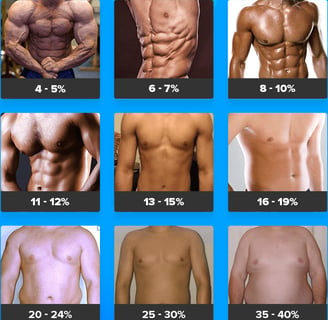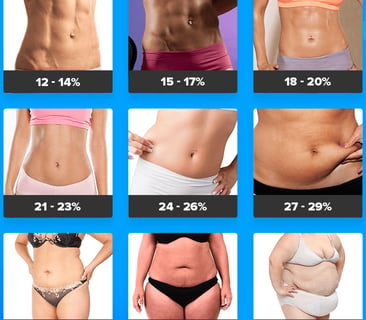
Body Fat Percentage: Setting Targets for Health and Longevity
CARDIO TRAININGFITNESS
Dr Osman El-Koubani, MD
8/17/20245 min read


Understanding Body Fat Percentage
Body fat percentage is one of the most critical indicators of your overall health and fitness. It represents the proportion of your body weight that is made up of fat. Unlike Body Mass Index (BMI), which only considers your height and weight, body fat percentage provides a more accurate picture of your body composition and the associated health risks or benefits. This article will guide you through understanding the different ranges of body fat, their health implications, and how to set a target range that supports longevity and well-being.
What is Body Fat Percentage?
Body fat percentage is the ratio of fat mass to your total body weight. For example, if you weigh 150 pounds and have 30 pounds of fat, your body fat percentage is 20%. It’s important to note that your body needs a certain amount of fat for essential functions, including hormone production, insulation, and energy storage.
Types of Body Fat
Before diving into the ranges, it's important to understand that not all body fat is the same:
Essential Fat: This is the minimum amount of fat necessary for normal physiological functions. It makes up about 2-5% of total body weight in men and 10-13% in women.
Subcutaneous Fat: Fat stored beneath the skin, which is the most visible type of fat.
Visceral Fat: Fat stored around internal organs. High levels of visceral fat are associated with increased risks of metabolic diseases.
Brown Fat: A type of fat that burns calories to produce heat, contributing to energy expenditure.
Body Fat Percentage Ranges and Health Implications
1. Essential Fat
Men: 2-5%
Women: 10-13%
Health Implications: Essential fat is crucial for survival, supporting critical functions like hormone regulation, vitamin absorption, and protecting internal organs. Falling below this range can lead to serious health issues, including hormonal imbalances, compromised immune function, and organ failure.
2. Athletic Range
Men: 6-13%
Women: 14-20%
Health Implications: Individuals in this range typically have higher muscle mass and lower fat stores, which can be beneficial for performance in sports and other physically demanding activities. However, maintaining such a low body fat percentage over time, particularly in women, can lead to issues like menstrual irregularities and decreased bone density if not managed carefully.
3. Fitness Range
Men: 14-17%
Women: 21-24%
Health Implications: This range is often seen in individuals who engage in regular exercise and maintain a balanced diet. It represents a healthy balance between muscle mass and fat. Individuals in this range typically have lower risks of cardiovascular diseases, type 2 diabetes, and other obesity-related conditions.
4. Average Range
Men: 18-24%
Women: 25-31%
Health Implications: Falling within the average range is generally considered healthy for most people. However, creeping towards the upper limit may indicate an increased risk of developing metabolic syndrome, heart disease, and type 2 diabetes. Maintaining an active lifestyle and balanced diet can help manage body fat within this range.
5. Overfat/Obese Range
Men: 25% and above
Women: 32% and above
Health Implications: Body fat percentages in this range are associated with higher risks of numerous health issues, including heart disease, stroke, type 2 diabetes, and certain cancers. Excess visceral fat in particular is a significant risk factor for metabolic syndrome. It’s crucial for individuals in this range to adopt lifestyle changes aimed at reducing body fat to avoid serious health complications.
Assessing and Measuring Body Fat Percentage
Methods of Measurement
There are several ways to measure body fat percentage, each with varying levels of accuracy:
Skinfold Calipers: This method involves measuring the thickness of skinfolds at various points on the body. It's a relatively simple and inexpensive method, though it can be less accurate depending on the skill of the person taking the measurements.
Bioelectrical Impedance Analysis (BIA): Many scales and handheld devices use this method, which sends a small electrical current through the body to estimate fat mass. It's easy to use but can be influenced by hydration levels.
Dual-Energy X-ray Absorptiometry (DEXA): This is one of the most accurate methods, providing a detailed breakdown of body composition, including fat mass, lean mass, and bone density.
Hydrostatic Weighing: This method measures body composition by submerging you in water and calculating body density. It is highly accurate but not widely accessible.
Air Displacement Plethysmography (Bod Pod): Similar to hydrostatic weighing, this method measures body composition by assessing how much air your body displaces. It’s accurate but may not be readily available.
Image estimate FFMI for men
Image estimate FFMI for women
Setting Your Target Body Fat Percentage
When determining your target body fat percentage, consider your health goals, age, gender, and lifestyle. For most individuals aiming for optimal health and longevity, the following target ranges are recommended:
Men: 10-20%
Women: 18-28%
These ranges offer a good balance between maintaining muscle mass, minimizing health risks, and supporting overall well-being. Athletes or those involved in physically demanding sports may aim for the lower end of these ranges, while those focused on general health and longevity may target the middle to upper end.
Health Implications of Different Body Fat Levels
Low Body Fat (Below Essential Levels)
Risks: Low body fat can lead to serious health issues, including hormone imbalances, weakened immune function, decreased bone density, and potential damage to internal organs. Women are particularly at risk of amenorrhea (loss of menstrual periods) and osteoporosis when body fat is too low.
Healthy Body Fat (Within Target Ranges)
Benefits: Maintaining body fat within the target range supports hormone regulation, cardiovascular health, and metabolic function. It also provides enough energy reserves for daily activities and protects vital organs.
High Body Fat (Overfat/Obese Range)
Risks: High body fat, particularly visceral fat, is associated with an increased risk of chronic diseases, including heart disease, type 2 diabetes, and certain cancers. It can also lead to joint problems, sleep apnea, and decreased quality of life.
Practical Steps to Achieve and Maintain Target Body Fat Percentage
1. Adopt a Balanced Diet
Focus on whole foods, including lean proteins, healthy fats, and complex carbohydrates. Avoid processed foods, excessive sugars, and unhealthy fats that contribute to fat accumulation.
2. Incorporate Regular Exercise
Engage in a mix of aerobic exercises, like walking, running, or cycling, and strength training to build muscle and burn fat. Aim for at least 150 minutes of moderate aerobic activity or 75 minutes of vigorous activity per week, combined with two days of strength training.
3. Monitor Progress
Regularly track your body fat percentage using one of the methods mentioned earlier. Adjust your diet and exercise routine based on your progress to stay within your target range.
4. Prioritize Sleep and Stress Management
Poor sleep and chronic stress can increase cortisol levels, leading to fat accumulation, especially visceral fat. Aim for 7-9 hours of sleep per night and practice stress-reducing activities like meditation, yoga, or deep breathing exercises.
5. Stay Consistent
Achieving and maintaining a healthy body fat percentage requires consistent effort over time. Make gradual, sustainable changes to your lifestyle rather than seeking quick fixes.
Conclusion: The Path to Optimal Body Fat and Longevity
Understanding your body fat percentage and its implications is crucial for setting effective fitness goals and enhancing longevity. By aiming for a target range that aligns with your health and fitness goals, you can reduce the risk of chronic diseases, improve your quality of life, and potentially extend your lifespan. Remember, achieving and maintaining a healthy body fat percentage is a journey that involves a balanced approach to diet, exercise, and overall lifestyle.
Call to Action
Ready to take control of your health and set the right fitness goals? Start by assessing your current body fat percentage and make a plan to reach your target range. Check out this article for how you can assess how to do it!




Longevity
Maximising quality of life and lifespan through prevention.
Contact
info@healthandhustle.com
© 2024. All rights reserved.
